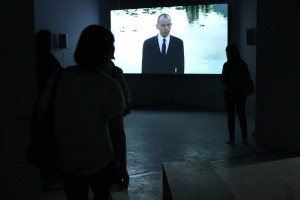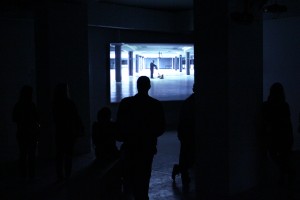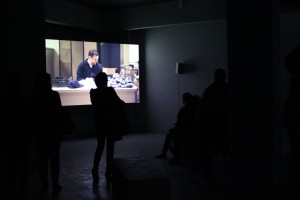Temple Bar Gallery and Studio’s
September 3 – October 8 2011

The exhibition titled The Inhabitant comprises two of Healy’s most recent film works Fugue, 2011 and Last Man, 2011. Healy’s work encompasses film, video, and photography and the subject matter references popular culture, science fiction and film.
The films reflect Healy’s interest in early science fiction novels such as Yevgeny Zamyatin’s, dystopian novel We (1921) and Edward Bellamy’s Looking backward 2000 to 1887 (1888) which in turn led to his preoccupation with the utopian project. Fugue is loosely based on the character Julian West from Bellamy’s looking backward where the character is cast forward in time to the year 2000 in Boston where he describes the future city. Fugue is set in Tapiola, a garden city that was built in the 1950’s and 1960’s in Finland. It was an ideological project in its approach to modern living and the planning of which was highly influenced by the writings of Von Hertzen’s whose starting point in planning was the individuality of man and closeness to nature. Bellamy’s Looking Backward was also influential in the development of garden cities. In the film we see an isolated figure move through the deserted landscape; the modernist project is overgrown almost reflecting on nature’s dominance over the architecture of

Installatio view
The piece is a dystopian depiction of the present while also a psychological portrait of an individual that has become dislocated from time. The term Fugue describes a specific psychological disorder that refers to ‘double consciousnesses’ or a psyhogenic flight. The term was first classified in the late 19th century. A fuguer is an individual who moves between identities that are the product of competing temporalities. The primary symptom of fugue is unexpected travel away from home or work usually accompanied by confusion about personal identity or even an assumption of a new identity and the inability to recall ones past. The film depicts this sense of estrangement through the use of the deserted landscape and lack of expression by the individual, which allows the viewer little relation or empathy for the character. This dislocation or schism is continued in Last Man.
A disused airport terminal in Cork, Ireland completed in 1961 provides the backdrop for Last Man. The films protagonist continues the futile task of working within the empty building, the camera lingers on defunct waiting and baggage claim areas, projecting a possible future where airports will become a thing of the past, leisure travel will no longer be part of the everyday.

Installation view
Both films can be viewed as a meditation on the degradation of urban living and dystopian projections of the future where the individual that has so much a part of late capitalism becomes the catalyst of its own demise. Both films are indicative of the current malaise that is reflected in contemporary society. The disenfranchised have become more isolated and the resulting backlash can be seen in the riots in our sprawling metropolis’s. The question being is this the utopia that past architects aspired to.